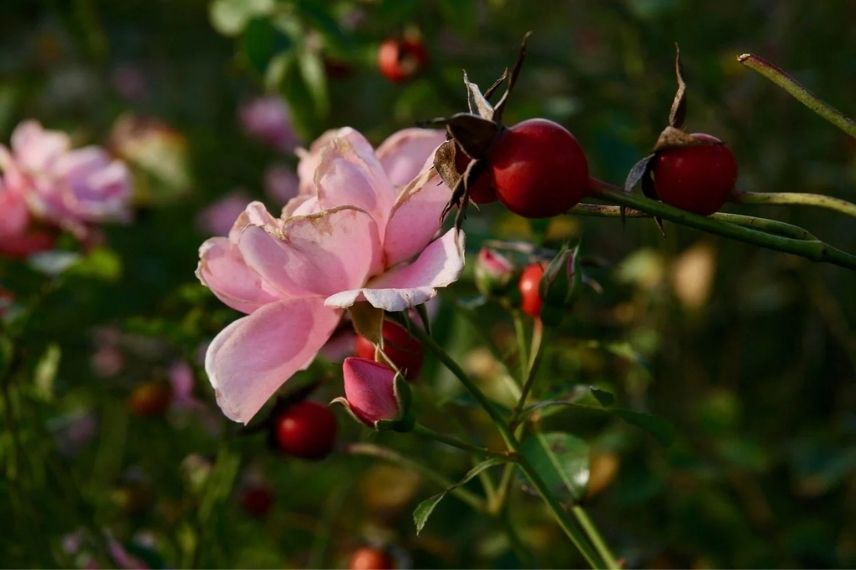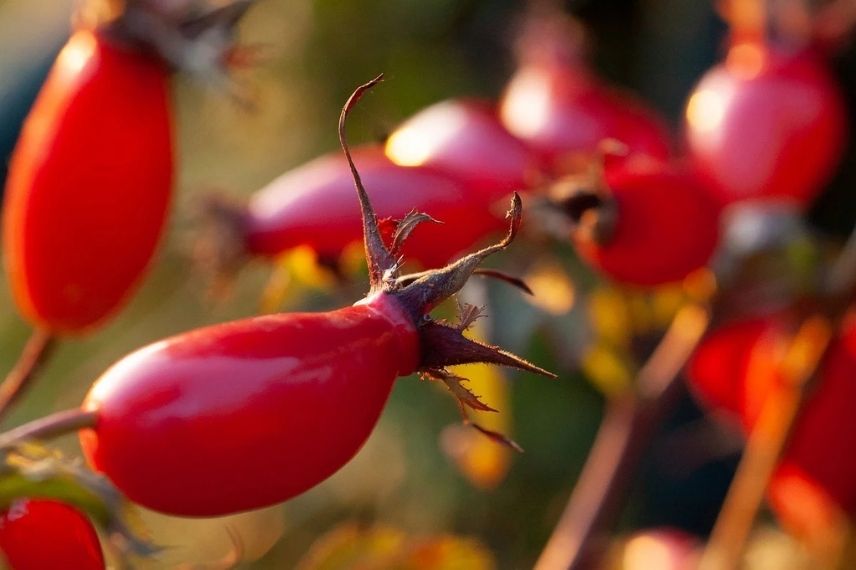Belonging to the Rosaceae family, the dog rose is a thorny bush, the most common species of which is Rosa Canina. A wild species cherished for its pretty 5-petaled heart-shaped flowers, adorned with long golden stamens. Ranging from pink to white, they stand out easily amidst medium-green foliage with a bushy habit.
Appearing between May and June, its flowers gradually give way to lovely scarlet-red fruits, called "hips" or "itchy-backs", due to the multitude of tiny hairs found inside. Edible, they are prized for their high vitamin C content, mainly located under the skin, where you can also find vitamins B1 and B2, as well as potassium.
Also consumed as syrup or herbal tea, the dog rose berry can be made into jam: exceptional for its bright red colour, it has the consistency of chestnut jam, while offering a sweet and slightly tangy taste.
In any case, it requires a lot of fruit to obtain just a few spoonfuls of this precious nectar. Discover our tutorial to learn everything from picking to preparing the jam.
How to pick dog rose hips?
The dog rose in the garden
In the garden, Rosa canina is ideally planted between March and April or between October and November, in neutral, deep, humus-bearing, fresh, well-drained soil with good sun exposure. Once well-established, the dog rose can grow up to 3 metres in height and 2.50 metres in width. While pruning is not mandatory, it is advisable to remove dead wood during the winter and shorten older branches to stimulate new shoots. During flowering, between May and June, the bush is adorned with beautiful white to pink flowers, which give way to hips that can be harvested in early autumn.
Patricia's tip: Sometimes, I leave the fruit until the first frosts to gather hips with a more pronounced flavour!

Picking dog rose hips
As it is a rose bush, it is advisable to wear gloves to protect yourself from its sharp thorns: the hips should be soft to the touch, with pulp that comes out easily when pressed. Better yet, use pruning shears and cut the branches as close to the fruit as possible to avoid tearing them. Don’t forget that the hairs are urticating to the hands.
Patricia's tip: To follow the principles of sustainable picking, I advise you not to take more than 10 to 20% of the tree's fruit. Not to mention that these berries also feed animals in winter. Finally, prefer the largest fruits: mainly composed of seeds, they will offer more flesh for your dog rose hip jam.
Storing dog rose fruit
Once harvested, you can either dry them or freeze them to preserve them. The first method is more commonly used for infusions. For the second, simply place the fruit in a freezer bag or containers and let them thaw at room temperature, half a day before use.

Dog rose hip jam: the recipe
Here are the steps to successfully make your dog rose hip jam when the fruit is fully ripe. Note that if the harvested fruit is firm, cut it in half and remove the seeds and hairs inside before cooking (step 2): this step, more tedious, is offset by the reduction in sieving (step 3).
Step 1. Preparing the dog rose fruit
After responsibly picking the dog rose fruit, separate the stems from the fruit (if you used pruning shears for harvesting) and wash off any dust stuck to the skin. At this stage, it is essential to remove the peduncles (the flower stalk) and the fly (the black part at the end of the hip).
Step 2. Cooking the hips
Place the fruit in a saucepan and cover with water. Bring to a boil, reduce the heat, and let them cook for a good half hour, until the hips are tender.
Step 3. The masher and sieve
Next, the hips must be passed through a masher, to remove most of the seeds, skins, and hairs. If the consistency is too thick, you can add a little cooking water. The resulting purée is then sieved once, followed by a second time, to remove any stubborn urticating hairs.
Patricia's tip: After the two sievings, I pass the purée through a fine muslin or cloth, which extracts only the best of the nectar.
Step 4. Adding sugar and lemon
To the prepared mixture, all that remains is to add a little sugar—about 700g for 1kg of dog rose fruit purée. After mixing well, add a little lemon juice, before letting it macerate overnight.
Step 5. Final cooking of the hips
Place the mixture in a saucepan over low heat, once it comes to a boil, stir constantly for 5 to 10 minutes. The final consistency should resemble a thick cream. Then, pour the contents into one or more jam jars, previously sterilised, before sealing and turning them upside down. Only when they are cold can you enjoy it!
Patricia's tip: I like to add a vanilla pod, scraped just before the final cooking of the dog rose fruit, to enhance the original flavour of the hips.
































Comments